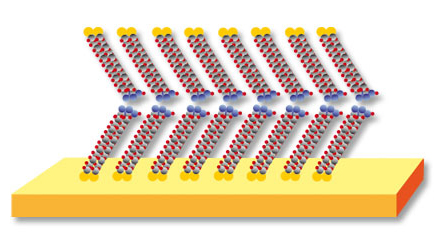PM-IRRAS


Applications on metal surfaces
- Submonolayers, monolayers
- Ultrathin layers or coatings
- Biomolecules
- Corrosion processes
- Sample measurements without reference measurements
- Water vapour free spectra
Method
“Infrared reflection absorption spectroscopy“ (IRRAS) is an established analytical technique for the characterization of adsorbed matter and thin layers on metal surfaces. In IRRAS experiments, the sample is investigated in reflection geometry under grazing incidence (typically 80°). The sensitivity of this method can be significantly enhanced by employing the polarization modulation technique (PM). In particular the disturbing atmospheric absorptions, caused by water vapour and CO2, are thereby eliminated. The PM-IRRAS technique takes advantage of the different absorption of p- and s-polarized light at large angles of incidence. The ultrathin layers on metal surfaces interact with the p-polarized fraction of light, but not with the s-polarized one.
PM-IRRAS studies the high-frequency modulation between s- and p-polarization, allowing the simultaneous measurement of two signals: 1. the difference spectrum between s- and p-polarized light and 2. the corresponding sum spectrum. The PMA 50 module is capable of simultaneous data acquisition by utilizing 24Bit dual-channel ADC. Compared to the classical IRRAS method, PMA 50’s dual channel measurement provides an essential advantage: a reference measurement is no longer required! Thus it is possible to study very thin films, adsorbed molecules from the gas phase and organic (sub-)monolayers on reflecting surfaces in detail.
Instrument
The PMA 50 was specifically developed for polarization modulated IR spectroscopy. Besides methods based on linear dichroism, such as PM-IRRAS, it also enables the investigation of circular dichroism, e.g. VCD spectroscopy. All optical and electronic components are specially optimized for polarization modulation, which is generated by a built-in photoelastic modulator (PEM). The PMA 50 module can be coupled to Bruker’s INVENIO and VERTEX series FT-IR spectrometers providing unmatched sensitivity as well as flexibility. Moreover, the spectrometer can also be used for other applications. Unlike the VCD configuration where the sample is measured in transmission, in a PM-IRRAS experiment the IR light is reflected by a metallic surface and then detected. The unit with lens and detector is mounted on an arcuate steel rail that can be moved to adjust the angle of incidence to provide maximum flexibility to the user. Due to this elaborate design, the angle of incidence (with respect to the surface normal) can easily and continuously be adjusted between 70° (option: 32°) and 90°. Furthermore the PMA 50 allows for fast and simple switching between PM-IRRAS and VCD configuration.